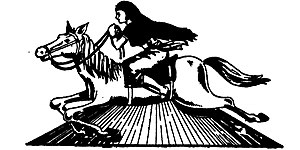Thumleima
| Noinu Thumleima | |
|---|---|
Goddess of salt and salt wells[1] | |
| Member of Lairembis | |
 "Thumleima" written in the archaic Meitei Mayek abugida | |
| Other names | Thumkhong Lairembi[2] |
| Affiliation | Meitei mythology (Manipuri mythology) and Meitei religion (Sanamahism) |
| Abodes | Salt brines |
| Symbol | Salts |
| Texts | Phouoibi Waron |
| Gender | Female |
| Region | Ancient Kangleipak (Antique Manipur) |
| Ethnic group | Meitei ethnicity |
| Festivals | Lai Haraoba |
| Personal information | |
| Parents |
|
| Siblings | |
| Greek equivalent | Amphitrite |
| Roman equivalent | Salacia |
Noinu Thumleima (Meitei: ꯅꯣꯢꯅꯨ ꯊꯨꯝꯂꯩꯃ) or Thumkhong Lairembi[2] (Meitei: ꯊꯨꯝꯈꯣꯡ ꯂꯥꯢꯔꯦꯝꯕꯤ) is the goddess of salt and salt wells in Meitei mythology and religion of Ancient Manipur (Antique Kangleipak).[1][3][4][5][6] She is a sister (or friend) of the goddesses, Phouoibi (Phouleima), Ngaleima and Ereima (Ireima).[1] People pray to her so there will be enough salt. Salt is an important part of the human diet.[3]
She is a wife of Pakhangba, the royal deity.[2]
Name[edit]
The Meitei female given name "Thumleima" (tʰum.lə́i.mə, ꯊꯨꯝꯂꯩꯃ) is made of two words. These words are "Thum" (tʰum, ꯊꯨꯝ) and "Leima" (lə́i.mə, ꯂꯩꯃ). In Meitei, "Thum" (tʰum, ꯊꯨꯝ) means salt, usually the common salt.[7] In Meitei, "Leima" (lə́i.mə, ꯂꯩꯃ) means queen, mistress or lady.[8]
Another name of goddess Thumleima is "Thumkhong Lairembi" (ꯊꯨꯝꯈꯣꯡ ꯂꯥꯢꯔꯦꯝꯕꯤ). The Meitei word "Thumkhong" (tʰum.kʰoŋ, ꯊꯨꯝꯈꯣꯡ) is made up of two component words, "Thum" (tʰum, ꯊꯨꯝ) and "Khong" (kʰoŋ, ꯈꯣꯡ). "Thum" (ꯊꯨꯝ) means salt. "Khong" (kʰoŋ, ꯈꯣꯡ) means mine (of salt or metallic ores).[9] So, "Thumkhong" (tʰum.kʰoŋ, ꯊꯨꯝꯈꯣꯡ) means salt ditch or salt brine or salt mine or salt well.[10] Another Meitei word "Lairembi" (ꯂꯥꯢꯔꯦꯝꯕꯤ) is made up of three component words, "Lai" (ꯂꯥꯢ), "-rem" (-ꯔꯦꯝ) and "bi" (ꯕꯤ). "Lai" (ꯂꯥꯢ) means "God". "-rem" (-ꯔꯦꯝ) or "-lem" (-ꯂꯦꯝ) means "excellent". "bi" (ꯕꯤ) or "pi" (ꯄꯤ) is a suffix to denote feminine gender. So, "Lairembi" (ꯂꯥꯢꯔꯦꯝꯕꯤ) means a goddess.[11]
Association with other gods[edit]
The Goddess Thumleima is one of the divine manifestations of Leimarel (Leimalel). Leimalel is the supreme mother earth goddess. It is said that Leimalel becomes Thumleima when she is in the salt mine.[3][12] Thumleima is also considered as one of the divine incarnations of goddess Imoinu.[6]
In popular culture[edit]
- Phou-oibi, the rice goddess is a 2009 ballad opera. It was performed by the Laihui Ensemble. It is based on the story of the goddess and her sister Phouoibi.[13][14]
- Phouoibi Shayon is a 2017 Manipuri mythology movie based on the story of the goddess and her sister Phouoibi.[15][16][17]
Related pages[edit]
- Imoinu (Emoinu) - Meitei goddess of wealth
- Ireima (Ereima) - Meitei goddess of water
- Leimarel (Leimalel) - Meitei goddess of earth
- Ngaleima - Meitei goddess of fish
- Panthoibi - Meitei goddess of civilization, love and warfare
- Phouoibi (Phouleima) - Meitei goddess of farm crops
References[edit]
- ↑ 1.0 1.1 1.2 Devi, Lairenlakpam Bino (2002). The Lois of Manipur: Andro, Khurkhul, Phayeng and Sekmai. Mittal Publications. ISBN 978-81-7099-849-5.
- ↑ 2.0 2.1 2.2 Singh, Moirangthem Kirti (1998). Recent Researches in Oriental Indological Studies: Including Meiteilogy. Parimal Publications.
- ↑ 3.0 3.1 3.2 Leimarel Mingkhei. 1970. p. 19.
{{cite book}}:|website=ignored (help) - ↑ Folklore Society (Great Britain). Folklore. Robarts - University of Toronto. London, Folk-lore Society.
- ↑ Jacobs, Joseph; Nutt, Alfred Trübner; Wright, Arthur Robinson; Crooke, William (1913). Folklore. Folklore Society.
- ↑ 6.0 6.1 Devi, Dr Yumlembam Gopi. Glimpses of Manipuri Culture. Lulu.com. ISBN 978-0-359-72919-7.
- ↑ "Learners' Manipuri-English dictionary.Thum". uchicago.edu. 2006.
- ↑ "Learners' Manipuri-English dictionary.Leima". uchicago.edu. 2006.
- ↑ "Learners' Manipuri-English dictionary.Khong". uchicago.edu. 2006.
- ↑ "Learners' Manipuri-English dictionary.Thum+Khong". uchicago.edu. 2006.
- ↑ "Learners' Manipuri-English dictionary.Lairembi". uchicago.edu. 2006.
- ↑ Singh, L. Bhagyachandra (1991). A Critical Study Of The Religious Philosophy. p. 73.
- ↑ "Laihui Ensemble Manipur – Phou-oibi, the Rice Goddess to perform at Esplanade Theatre Studio Singapore". www.manipur.org.
- ↑ "Phou-Oibi, the Rice Goddess by Laihui Ensemble". sgmagazine.com.
- ↑ "Phouoibi Shayon to be shown at Shankar : 01st apr17 ~ E-Pao! Headlines". e-pao.net.
- ↑ "Phouoibi Shayon to be shown at Shankar – Manipur News".
- ↑ Gurumayum, Maheshwar. "Film Release - Imphal Times". www.imphaltimes.com.
Other websites[edit]

